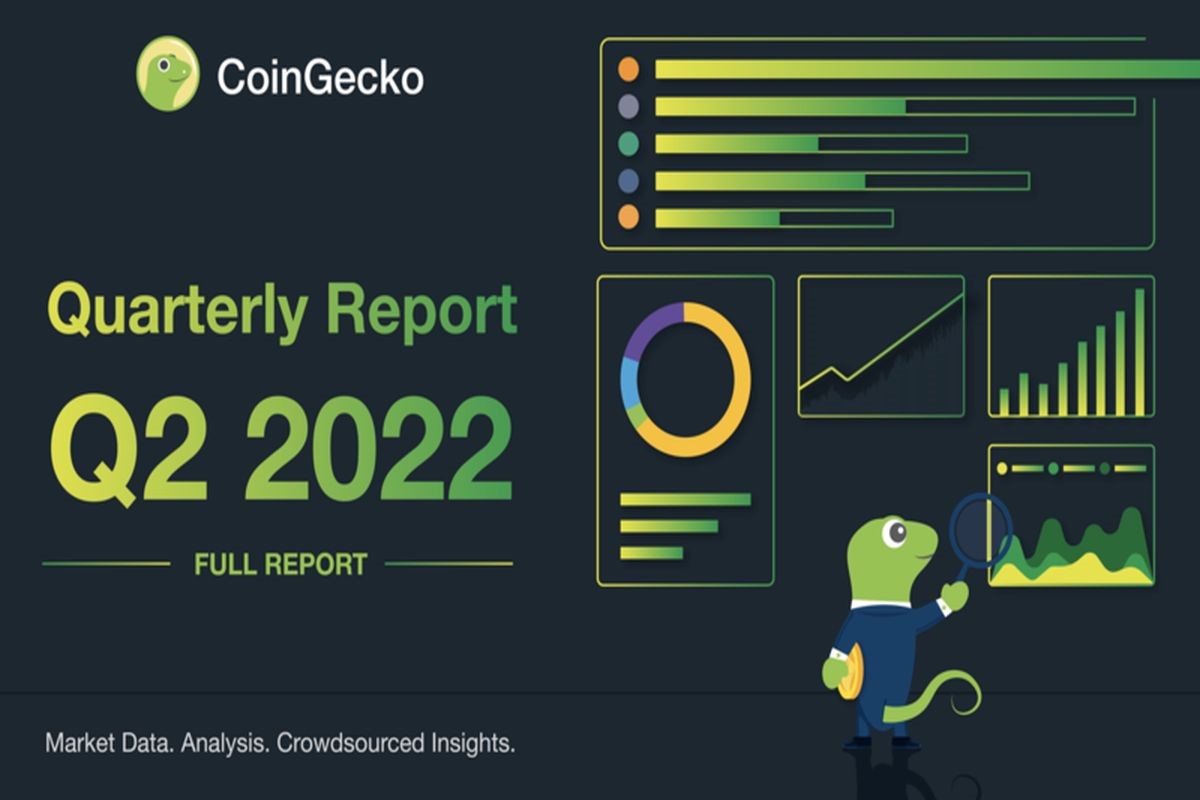In Q2 2022, a lot of pain was experienced since several major unfortunate events dominated the crypto space. The top 30 cryptos have lost more than half of their market cap since the previous quarter, as the total market cap sat at around $900 billion on June 30.
While prices have tumbled and plummeted in this quarter, spot trading volumes have remained quite stable at about $100 billion daily. In this quarter, the flow on effects of a continued liquidity crunch coupled with the weight of a hawkish macro environment seemed to burden the cryptocurrency market.
In the second quarter, Ethereum and Bitcoin saw historically massive drawdowns, with ETH facing 11 consecutive weeks of negative returns. With that in mind, constant accumulation and buy-side flows on the desk were critical highlights in Q2 2022.
Interestingly, there was a growing interest in structured product offerings and some institutions continued buying the dip even as others were liquidated. In some cases, investors managed to earn healthy yields while waiting for market entries and that was advantageous in the current cryptocurrency market environment given the increased risk in the credit lending markets.
Undeniably, risk management got the spotlight as this quarter’s pre-dominant theme. The investors that were over-exposed to exploited CeFi and DeFi platforms; Terra’s (LUNA) tokens, and the compromised credit counterparties arising from the collapse of Three Arrows Capital (3AC), encountered a highly rocky several months.
Related: Is The Crypto Market Combating A Lehman Brothers Moment?
Whilst the mismanagement of leverage and duration risk weighed massively on the sector and pushed billions of dollars in selling pressure, the resulting flushing out offered the space with lots of clarity surrounding the value of placing various digital assets and interacting with:
- Trustless and permissionless protocols with sustainable offerings
- Regulated companies with diligent risk management practices
- Custody solutions with self-sovereign private key ownerships
Regulatory Pressure Impacts Cryptocurrency Markets In Q2 2022
A significant uptick in regulatory attention continued throughout Q2. In the United States, the SEC launched an investigation into the Binance initial coin offering in 2017. Furthermore, the Lummis Bill was introduced and it aims to offer more structure to the cryptocurrency sector’s regulatory infrastructure in the United States.
In Europe, a lot of updates were introduced in the markets in the crypto assets (MiCA) network with the intention of guarding against market abuse and excessive manipulation. Based on the events that happened in Q2 2022, it is possible that global regulatory attention will keep coming.
Nonetheless, it seems that regulatory focus, at least for now, will be placed on safe practices and investor protections. Such developments will eventually benefit both the cryptocurrency sector and its participants. It is also possible to eliminate the barrier to entry for several investors sitting on the sideline pending more regularity clarifications.
The first six months of this year have marked the worst bi-annual return for the S&P since 1970. Looking to the next quarter and beyond, it is expected that rate hikes and quantitative tightening will continue, eventually limiting risk asset allocation.
With that in mind, the steadiness of accumulation in assets, like Bitcoin, shows promise for a consolidation phase in the short term. For the long-term investors, this offers a great opportunity to reposition and average in.
While the current market conditions seem dreary, it is crucial to recognize that it is not unfamiliar territory for the cryptocurrency asset class. Just as the macro conditions will slowly become more favorable, so too will the crypto market recover. The critical call is, and always has been, timing. Based on the long-term view and utilizing tools like structured products is the target of this game.
Here are the top cryptocurrency market highlights for Q2 2022:
Terra-ble Quarter For Stablecoins
The Top 15 stablecoins lost nearly 20% of their market capitalization or $33.9 billion in absolute terms. Before the eventual drop that wiped out around $18 billion in market cap, USTC overtook BUSD becoming the third-biggest stablecoin.
Tether retained its lead, although its share dropped by nearly 20%. USDC took the lead in Q2 2022 in terms of growth with nearly a 7% increase. On the contrary, FRAX and DAI nonetheless saw losses of 48% and 32% in market capitalization respectively, maybe due to the negative links with algorithmic stables.
The small drop (discounting USTC) in stablecoin market share indicates that a particular amount of capital has already exited the cryptocurrency ecosystem permanently, in contrast to last quarter when the investors possibly de-risked into stables amid the market uncertainty.
Terra’s Violent Collapse And bETH Contagion
With Terra’s collapse in May, users were bridging their bETH back to the mainnet and changing them to ETH through Curve. Simultaneously, huge liquidity pools (LPs) like 3AC, Celsius, and Amber also withdrew liquidity from the pool.
Total circulating stETH is now ~4.2M, which represents 30% of all the staked ETH and around 3.5% of the total ETH circulating supply. Notably, the stETH-ETH Curve pool is now down to $718M in TVL, which is significantly small compared to its peak of $5.6 billion on April 5.
It is crucial to note that stETH is not meant to be 1:1 to ETH. Hence, stETH to ETH redemption will just be unlocked post-Merge, and the users are taking on smart contract risk when staking Ether on Lido.
More Domino Effects On Three Arrows Capital
A big group of different investors had invested in Three Arrows Capital (3AC), who, sadly, were also victims of Terra’s untimely demise.
Some of the investments have come from centralized entities like Voyager and BlockFi that recorded heavy losses. On June 22, Voyager said that it had $650 million in exposure to 3AC. That was 58% of its loan book and was mostly unsecured.
Related: Voyager Digital Files For Chapter 11 Bankruptcy Protection
As a result of third-order effects, decentralized finance (DeFi) protocols like Maple Finance were not spared as some of the users’ funds were lent to Orthogonal Trading. That, in turn, had gone to Babel Finance, which is one of 3AC’s creditors.
DeFi’s Dominance Withered As Markets Trended Lower
The decentralized finance market cap suffered a huge drop, plunging from $142 billion to $36 billion within 3 months, together with the rest of the cryptocurrency market.
Most of the DeFi market cap was wiped out majorly as a result of the collapse of Terra and its stablecoin, UST. The Terra network projects were wiped out, together with protocols that supported the assets in the market.
As expected, the panic spread towards other stablecoins, leading to massive redemptions of USDT and other algo-stablecoins de-pegging. Apart from that, decentralized finance (DeFi) exploits have ramped up in Q2 2022 and it affected projects like Rari and Inverse. The attacks have negatively affected token prices as investors lose faith in the hacked protocols.
As Terra Collapses, Old And New Players Aim To Replace It
In Q2 2022, Ethereum regained some of its total value-locked (TVL) dominance, as alt chains started to shrink. While Ether has increased its share of TVL from around 54% to 60%, its overall TVL is still 52% lower when compared to Q1 2022.
Polygon, Avalanche, and Solana have managed to maintain their respective TVL shares, although in line with the general market downturn.
Even though Tron’s TVL has dropped from $4.8B to $3.9B, Tron’s TVL share has tripled from 2% to 6%, majorly due to the launch of its algo-stablecoins, USDD.
The downfall of LUNA and UST in May saw Terra’s TVL shrink to around 5%. By June 30, there was just more than $21M left on the network. The new Terra 2.0 network has less than that, reaching around $13 million TVL.
Related: Is the Whole Crypto Market Being Held Together by Sam Bankman-Fried and Alameda Research?
OpenSea’s Dominance Drops In Dwindling Market As Competition Thrives
OpenSea successfully retained its wobbling hold over the top position. Nonetheless, in May and June, Magic Eden and X2Y2 appeared to have caught up, taking their turns to overtake OpenSea’s daily and even weekly volume.
OpenSea’s integration of Solana appeared to have “backfired”, opening up the floodgates for Solana nonfungible tokens (NFTs), but one that ended up profiting Magic Eden a lot more. The NFT space might have shrunk but Magic Eden was getting a majority share of it by the end of Q2 2022 (32%).
Just like LooksRare in Q1, X2Y2 surged rapidly as traders capitalized on its rebate and incentive program with wash trades. Without these wash trades, it would put its volume at around LooksRare’s level.
Monthly Crypto Trading Volume For Q2 2022 Was Averaging Below $100B
Top 10 decentralized exchanges (DEXs) recorded up to $274 billion in spot trading volume in Q2 2022, recording a monthly average of $92 billion. Compared with Q1 2022 which saw a total of $446 billion and a monthly average of $149 billion. When integrated across all chains, Uniswap is the dominant DEX with a 60% market share.
Nevertheless, Curve recorded the biggest quarterly growth (383%), possibly due to the collapsed USTC pools and the flight to stablecoins in the bear.
Strikingly, DEXs on BNB (PancakeSwap and Dodo) and Solana (Serum and Jupiter) have increased or maintained their relative market share, indicating real market activity on chains outside Ethereum.
















